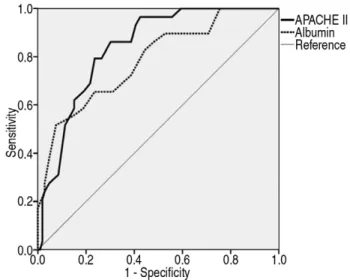세계보건기구(World Health Organization, WHO)에 따르면 해마다 약 300만명이 중등도 살충제 중독으로 추 정된다
1). 1996년부터 2005년까지의 국내 살충제 중독으 로 인한 사망자는 25,360명으로, 이는 전체 중독 사망자
유기인계 살충제 중독환자에서 30일 사망률에 대한 예후 예측인자로서의 저알부민혈증의 유용성
경상대학교 의과대학/의학전문대학원 응급의학교실1 경상대학교 건강과학연구원2
김소연
1∙이륜경
1∙김태후
1∙김동훈
1,2∙김태윤
1,2이수훈
1,2∙정진희
1,2∙이상봉
1∙강창우
1,2Hypoalbuminemia as a Predictor of 30-day Mortality in Patients with Acute Organophosphate Insecticide Poisoning
So Yeon Kim, M.D.
1, Ryun Kyung Lee, M.D.
1, Tae hu Kim, M.D.
1,
Dong Hoon Kim, M.D., Ph.D.
1,2, Taeyun Kim, M.D., Ph.D.
1,2, Soo Hoon Lee, M.D.
1,2, Jin Hee Jeong, M.D.
1,2, Sang Bong Lee, M.D.
1, Changwoo Kang, M.D., Ph.D.
1,2Department of Emergency Medicine, Gyeongsang National University School of Medicine, Jinju
1, Institute of Health Sciences, Gyeongsang National University, Jinju
2, Korea
Purpose: The association of hypoalbuminemia with 30-day in-hospital mortality in patients with organophosphate insecticide poisoning (OPI) was studied.
Methods: This retrospective cohort study was conducted between January 2006 and November 2013 in the emer- gency department (ED) after OPI poisoning. A Kaplan-Meier 30-day survival curve and the log-rank test were used to analyze patients stratified according to serum albumin levels on ED admission (hypoalbuminemia or normo-albu- minemia). Independent risk factors including hypoalbuminemia for 30-day mortality were determined by multivariate Cox regression analysis.
Results: A total of 135 patients were included. Eighty-eight (65%) patients were male and the mean age was 57.3±
17.0 years. Serum albumin, mean arterial pressure, and Glasgow coma scale score were significantly higher in the survival group than the non-survival group. APACHE II score was significantly lower in the non-survival group than the survival group. The mortality of the hypoalbuminemia group (serum albumin <3.5 g/dl) was 68.8%, while that of the normo-albuminemia group (serum albumin ≥3.5 g/dl) was 15.1%. The area under the ROC curve of the serum albumin level was 0.786 (95% CI, 0.690-0.881) and the APACHE II score was 0.840 (95% CI, 0.770-0.910).
Conclusion: Hypoalbuminemia is associated with 30-day mortality in patients with OPI poisoning.
Key Words: Organophosphate, Insecticide, Poisoning, Hypoalbuminemia, Mortality
원원 저저
책임저자: 강 창 우
경상남도 진주시 강남로 79
경상대학교 의과대학/의학전문대학원 응급의학교실 Tel: 055) 750-8216, Fax: 055) 757-0514
E-mail: em6766@gmail.com
투고일: 2017년 5월 8일 1차 심사일: 2017년 5월 30일 게재 승인일: 2017년 6월 19일
중의 58.3%를 차지한다
2).
유기인계 살충제는 전세계에서 많이 사용하고 있는 살 충제 중 하나로, 특히 아시아 국가에서 흔하게 사용되고 있다. 유기인계 살충제는 살충 효과가 뛰어난 반면, 만약 사람이 음독하면 매우 치명적이기 때문에 유기인계 살충 제 중독의 환자의 경우 그 중증도가 높으며, 중환자실로 입실하는 경우가 많다
3). 유기인계 살충제는 음독 후 사망 률이 4-30%로 상당히 높으며, 이는 의학적으로 중요한 문 제점으로 고려되고 있다
4,5).
유기인계 살충제는 생체 내에서 아세틸콜린에스터라제 의 작용을 억제하여 아세틸콜린의 과도한 축적을 일으킴 으로써 말초신경과 중추신경계 내의 시냅스에 있는 무스 카린 및 니코틴 수용체에 영향을 미친다
6). 그 결과로 많은 유기인계 중독 환자가 호흡부전, 신경학정 후유증, 심폐정 지까지 발생하며, 이로 인해 높은 사망률을 나타낸다
7-11). 따라서, 유기인계 중독 환자의 예후와 관련된 여러 예측 인자에 대한 연구가 이루어졌고, 그 대부분은 혈액검사와 관련되어 있다. 선행된 여러 연구에서 적혈구 분포폭 (Red cell distribution width), GCS 점수, Acute Physiology and Chronic Health Evaluation (APACHE) II 점수, Simplified Acute Physiology Score (SAPS) II 점수, S100B 단백, C 반응성 단백, 심박수, 교정 QT 간격 등이 유기인계 중독 환자의 예후와 관련된 인자로 알려져 있다
12-18).
혈청 알부민의 농도는 여러 질병(심부전, 심근경색, 폐 렴 등)에서 예후의 예측 요인이나 위험 요인으로 보고되
어 왔다
19-21). 하지만 혈청 알부민과 중독 환자의 사망률의
연관성에 대한 연구는 아직까지 거의 없다. 그래서, 본 연 구에서는 유기인계 살충제 중독 환자에서 혈청 알부민 농 도가 사망률과 연관성이 있다는 가설을 세웠고, 이를 바탕 으로 유기인계 살충제 중독 환자의 초기 혈청 알부민 농도 와 30일 사망률의 연관성을 평가하기 위하여 시행하였다.
1. 연구대상
본 연구는 연간 약 3만여 명의 환자가 내원하는 일개 3 차병원 응급의료센터에 2006년 1월 1일부터 2013년 12 월 31일까지 8년간 유기인계 살충제 중독으로 진단된 135 명의 환자를 대상으로 의무기록을 후향적으로 분석하였 다. 본 연구는 병원 내 임상윤리위원회(IRB, 2015-03- 013)의 승인 후 시행되었다.
2. 대상 환자군 및 정의
연구 기간 동안 본 의료기관의 응급의료센터를 내원하 여 유기인계 살충제 중독으로 진단 받은 환자를 대상으로 하였으며, 16세 미만의 소아, 다른 약물을 동시에 음독한 환자, 치료 도중 타 병원으로 전원 된 환자 등은 연구대상 에서 제외되었다. 유기인계 살충제 중독의 정의는 보호자 와 환자의 병력청취에서 유기인계 살충제를 음독하였거 나 농약병을 수취하고 유기인계 살충제 중독의 전형적인 증상(타액분비, 유루, 배뇨, 설사, 구토, 기도 분비물 증가, 기관지경련, 서맥 등)을 나타내는 경우로 정의하였다
13).
3. 대상 환자의 치료
타 병원을 경유하였으나 아무런 처치가 없었거나 본원 으로 직접 바로 내원 한 환자의 경우 즉시 신속하게 위세 척을 시행하고 Pralidoxime (2-PAM)과 아트로핀을 투여 하였다. 인공호흡기 치료가 필요한 경우에는 시행하였고 초기 아트로핀의 투여에도 불구하고 배뇨, 설사, 타액분비 등과 같은 특징적인 콜린성 증상이 지속되는 경우에는 구 강과 기도의 분비물의 양에 따라 투여량을 2-4배까지 증 량하여 조절하였다. 2-PAM은 초기에 2 g을 약 15분간 투 약한 후 이후 10g-20g을 환자의 증상에 따라 최대 72시간 까지 점적 투여하였다.
4. 자료 수집
성별과 연령, 응급실 내원 시의 활력징후를 포함해서 이 전의 연구에서 예후와 연관이 있는 것으로 알려진 혈액검 사로 백혈구 수, 헤모글로빈, 동맥혈 pH, 동맥혈 이산화 탄소분압, 중탄산염, 혈청 알부민, 혈청 요소질소, 혈청 크 레아티닌 등을 표준화된 자료 수집 형식에 따라 연구 대상 기간동안 응급실로 내원한 환자의 내원 초기 수치를 수집 하였고 응급의학과 의사(S.Y.K., C.K.)가 검열하였다. 수 집된 자료와 사망률, APACHE II 점수를 조사하여 연관성 을 분석하였다.
5. 통계적 기법

